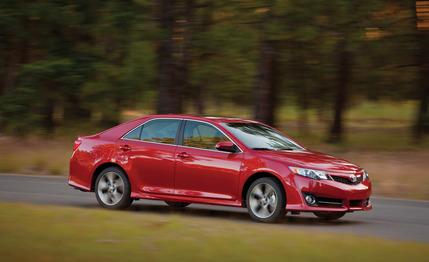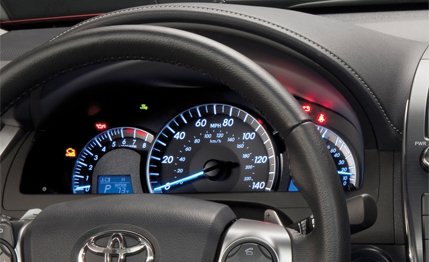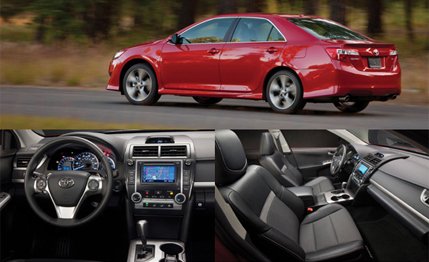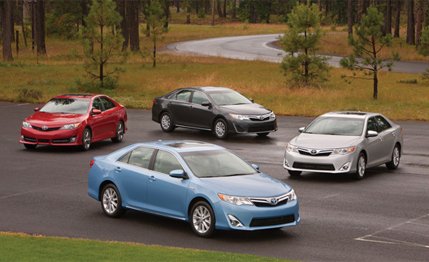
 First Drive Review
First Drive Review
Since 1997, the Toyota Camry has been the best selling car in America every year but one (2001). Last year, Americans bought 327,804 of them. Furthermore, the Camry platform serves as the foundation for the following Toyota and Lexus models: Avalon, Highlander, Sienna, Venza, ES350, RX350, and RX450h. Collectively, they added up to 738,415 sales in 2010—42 percent of Toyota’s American total. In other words, the Camry is the franchise.
Toyota has renewed this car like clockwork every five years, and the Camry has achieved an enviable position as the default mainstream sedan of choice—quiet, smooth, comfortable, reliable, and affordably priced. This new, seventh-generation, 2012 model is designed to maintain these virtues while offering more fuel efficiency and value.
Though Camry chief engineer Yukihiro Okane doesn’t say it, Toyota was perhaps embarrassed by losing out in mpg ratings to competitors, specifically the Ford Fusion hybrid and the Hyundai Sonata. Okane promises that this new model—with every engine—will at least tie for leadership in fuel-economy figures.
The base four-cylinder is now rated at 25 mpg city and 35 highway—up 3 mpg each. The V-6 is up 1 mpg each to 21/30. And the new hybrid LE leaps from 31/35 to 43/39 mpg, bettering the Fusion’s 41/36 ratings. The four-cylinder-only strategy used by competitors Hyundai and Kia doesn’t work for the Camry, as most of its spinoffs require a V-6.


Toyota achieved these improvements without direct fuel injection, downsized engines, or turbocharging. Instead, the company relied on basics such as a 155-pound diet, lower-rolling-resistance tires, sleeker sheetmetal, taller gearing, more-aggressive torque-converter lockup, and electric power steering. The 2.5-liter four and the 3.5-liter V-6 are both unchanged (see specifications).
The hybrid loses an additional 66 pounds and gets a more efficient Atkinson-cycle engine with an electric water pump, more-effective regenerative braking, increased electric-motor usage, and better high-voltage-battery control. While the nickel-metal-hydride battery capacity is unchanged, total power jumps from 187 horses to 200, shaving an estimated half a second from the 0-to-60 acceleration time.
This Camry is no stunner, but it looks smoother than its predecessor, if a bit slab-sided and shovel-nosed. Despite the weight reductions, the car’s length, width, height, and wheelbase are unchanged. The interior package remains roomy and comfortable. The hybrid benefits from a shrunken and relocated battery/electronics package, increasing trunk space from 11 cubic feet to 13. Other Camrys have 15 cubic feet of space in their trunks.
Mercifully, this bestseller reverses the trend toward budget materials that we’ve seen on many recent Toyotas. A new layered dashboard with genuine stitching on its leading edge has upgraded the ambiance. Large, ergonomically sculpted controls on the steering wheel help navigate the optional electronics, and the cockpit nicely splits the difference between cozy and spacious, though we’d like more-convincing faux aluminum and wood trim.


The SE would be our choice among the many models available (L, LE, SE, SE V-6, XLE, XLE V-6, hybrid LE, and hybrid XLE). SEs come with French-stitched upholstery, more-effective seat bolsters, a cleaner grille, and much less chrome. They also have a notably firmer suspension and a faster steering gear with more effort and feel. As you’d expect, the V-6 SE is quicker, but the four feels lighter on its feet.
The other Camrys are oriented, as always, toward cushy comfort. Wind and road noise are even more subdued than before, and the ride is smooth without being floaty—at least at moderate speeds. The new cars go down the road well, although the electronic power steering is notably lacking in on-center feel, even by Camry standards.
For those not sold on the SE, the new hybrid is an excellent choice, as it provides all of the comfort and utility of the other models with close to 40 mpg in real-world driving. Its integration of regenerative braking with hydraulic brakes is among the best we’ve ever experienced, and this car is more than a second quicker than the nonhybrid four-cylinder Camrys.
Though there are still a multitude of Camry models, Toyota has substantially reduced the number of build combinations. All of this adds up to reduced pricing.
The sticker for a base LE automatic, which Toyota expects to account for half of the sales, will be slightly lower than that of today’s LE. The cost of upgrading to an SE or an XLE will be cut roughly in half. And the hybrid, at least the new LE version, also will likely cost less than the current single hybrid model and is expected to account for at least 10 percent of sales. With its improved interior materials, higher mileage, and lower prices, this Camry ought to retain its sales crown.

